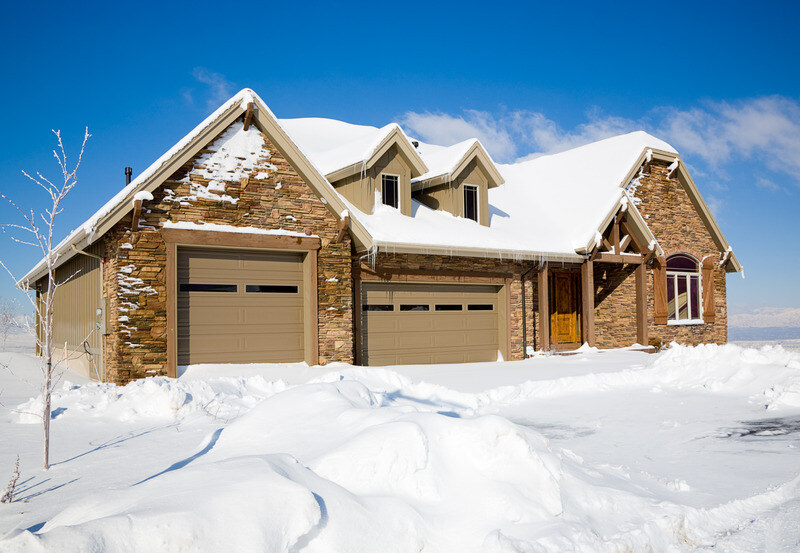
Seasonal Garage Door Maintenance for Year-Round Protection
Key Takeaways
1. Seasonal changes affect garage doors in different ways, with winter causing spring failures and summer heat damaging openers and seals.
2. Targeted maintenance like lubricating parts, checking weather-stripping, and cleaning tracks each season helps prevent breakdowns and extend your door’s lifespan.
3. Raynor Door Authority provides expert seasonal tune-ups and inspections to keep your garage door working safely and efficiently throughout the year.
How Does Season Affect Garage Doors
Garage doors are exposed to weather all year, and seasonal changes can influence how they work and how long they last. Each season creates different challenges that affect the door’s condition and performance.
Here’s how the seasons affect garage doors:
- Winter. Cold weather makes metal parts contract, which can cause broken springs, stiff rollers, and brittle weather-stripping. Snow and ice may block sensors or prevent the door from sealing properly.
- Spring. Moisture from rain can cause rust on steel doors and swelling in wooden doors. It is also the season when hidden winter damage often becomes more noticeable.
- Summer. Heat can make garage door motors strain, especially in poorly ventilated spaces. Strong sunlight fades paint and finishes, while high humidity can cause corrosion or warping in certain materials.
- Fall. Leaves, dirt, and other debris can clog tracks and sensors. Shifts in temperature can also affect door balance and the effectiveness of lubricants.
Regular seasonal maintenance, such as lubricating parts, sealing gaps, and cleaning tracks helps prevent problems and keeps garage doors running smoothly year-round.
Maintenance Tips for Summer Season
High heat and humidity can put extra stress on your garage door and its parts. Taking a few preventative steps during the summer helps extend its lifespan and ensures smooth operation.
Here are key maintenance tips for the summer season:
- Check the garage door opener. Heat can strain the motor. Test the opener for responsiveness and unusual noises. Replace worn batteries in remotes and keypads.
- Inspect weather-stripping. High temperatures can dry out and crack rubber seals. Replace any brittle or loose weather-stripping to keep hot air and pests out.
- Lubricate moving parts. Hinges, rollers, and springs may dry out faster in summer. Apply a silicone-based lubricant to reduce friction and prevent wear.
- Clean and protect the surface. Wash the door to remove dust, pollen, and debris. Consider applying a protective finish or paint to prevent fading and sun damage.
- Check garage ventilation. Poor airflow makes garages hotter, which can strain the opener and damage stored items. Install vents or fans if needed.
- Inspect for rust or corrosion. Humid conditions can accelerate rusting on steel parts. Treat any rust spots right away to prevent further damage.
Routine summer maintenance helps keep your garage door efficient and protects it from seasonal wear.
Maintenance Tips for Spring Season
Spring is the perfect time to inspect and refresh your garage door after the wear and tear of winter. Rain, temperature swings, and leftover salt or debris can all affect how well your door works.
Here are key maintenance tips for the spring season:
- Inspect springs and cables. Cold weather may have weakened them. Look for fraying, rust, or gaps in the coils, and schedule professional service if needed.
- Clean garage door tracks. Dirt, salt, and debris from winter can clog tracks. Wipe them down and make sure they are properly aligned.
- Check and replace weather-stripping. Moisture and freezing temperatures can crack seals. Replace damaged strips to keep out rain, drafts, and pests.
- Wash the garage door surface. Use mild soap and water to clean off grime, pollen, and salt residue. This prevents long-term staining or corrosion.
- Lubricate moving parts. Apply silicone-based lubricant to hinges, rollers, and springs to ensure smooth operation as temperatures rise.
- Test the safety features. Check auto-reverse sensors and balance to make sure the door closes safely and smoothly after the harsh winter.
Regular spring maintenance improves performance, extends lifespan, and prepares your garage door for the seasons ahead.
Maintenance Tips for Fall Season
Fall is an ideal time to prepare your garage door for the colder months ahead. Dropping temperatures, falling leaves, and seasonal storms can all impact how your door performs. A little maintenance now can prevent costly repairs in winter.
Here are key maintenance tips for the fall season:
- Clear leaves and debris. Clean around the tracks, hinges, and sensors to prevent blockages that interfere with smooth operation.
- Inspect and replace seals. Cooler weather makes gaps more noticeable. Replace worn or cracked weather-stripping to keep drafts and pests out.
- Check door balance. Disconnect the opener and lift the door halfway. If it falls or rises on its own, the springs may need adjustment by a professional.
- Lubricate hardware. Apply silicone-based lubricant to rollers, springs, and hinges to prevent squeaking and stiffness as the weather cools.
- Examine the door surface. Look for peeling paint, rust spots, or cracks in panels. Addressing these issues before winter moisture sets in helps protect the material.
- Test safety sensors. Ensure auto-reverse features and photo-eye sensors work correctly for safe operation during darker fall evenings.
Performing these steps in fall helps your garage door stay secure, efficient, and ready for the demands of winter.
Maintenance Tips for the Winter Season
Winter can be tough on garage doors. Freezing temperatures, ice, and snow increase the risk of mechanical issues and damage. Performing winter maintenance helps your door operate smoothly and keeps your home better insulated.
Here are key maintenance tips for the winter season:
- Inspect and replace bottom seals. Cold air and moisture often seep in through worn seals. Install flexible rubber or silicone seals that stay effective in low temperatures.
- Lubricate moving parts. Cold weather stiffens metal. Apply silicone-based lubricant to springs, hinges, and rollers to keep the system moving without strain.
- Check for ice buildup. Remove snow and ice around the threshold to prevent the door from freezing shut or straining the opener.
- Test the auto-reverse system. Ensure safety sensors and reverse mechanisms respond correctly, since cold weather can affect their sensitivity.
- Tighten hardware. Metal contracts in the cold, loosening bolts and screws. Check and tighten hardware to avoid rattling or misalignment.
- Inspect insulation. If your garage is attached, ensure the door panels are insulated properly to reduce heating costs and keep interiors more comfortable.
Carrying out these steps in winter reduces the risk of sudden breakdowns and helps your garage door withstand harsh conditions.
Protect Your Garage Door Year-Round with Seasonal Maintenance
Changing seasons can wear down your garage door more than you think. From summer heat that dries out seals to winter cold that cracks springs, each season brings its own challenges. Regular maintenance is the key to preventing damage, saving money, and keeping your garage door working smoothly all year.
At Raynor Door Authority, we help homeowners take the right steps every season. Whether it’s inspecting for rust, replacing worn weather-stripping, or testing safety features, our team can guide you or handle the work for you.
Next Steps:
- Follow a seasonal maintenance checklist to catch issues before they become costly repairs.
- Pay extra attention to your door’s condition at the start of each season—especially after extreme weather.
- Contact Raynor Door Authority for a professional inspection or to schedule a seasonal tune-up.
Year-round garage door care starts with the right habits. Let Raynor help you protect your door through every season.





